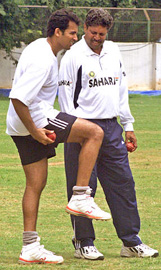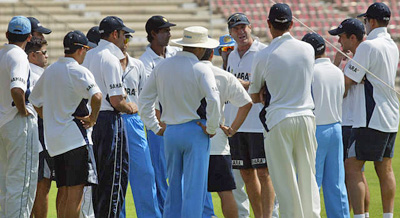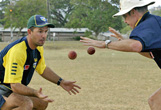ARTICLES
The eleven Commandments - for coaches and cricketers
- By Polly Umrigar
A cricketer who works hard has a greater chance of entering the big league than someone with a laid-back approach.It also helps if people who genuinely love the sport and love to share their knowledge guide the cricketers. On the basis of my relationship with the sport that has spanned over six decades, I have put together some 'observations' that might be of interest to budding cricketers and their coaches. Curiously, they add up to eleven.
The 'Eleven Commandments' are:

Kapil Dev helps out Zaheer Khan in the nets
1. 'What' and 'How':
Unfortunately, most of the cricket coaching is directed more towards 'what' to do with the ball. However, it is also important to tell youngsters 'how' to do it.
2. 'Coaches - always learn':
Schools constitute the nursery of cricket. However, very few of these 'nurseries' have a coach or 'sportsmaster' who has specialized knowledge. Consequently, his assistance to the boys is only of the 'general' type. Hence, these coaches should never rest on their laurels, and continue to increase their knowledge of the many aspects of the cricket, so that they can pass on the same to their pupils.
3. 'Penance and patience pay':
The use of films for instructional purposes and coaching clinics for schoolboys can be effective in improving cricketing skills, but the results will not be visible overnight. Hence, one should be patient and continue to work hard.
Unfortunately, most of the cricket coaching is directed more towards 'what' to do with the ball. However, it is also important to tell youngsters 'how' to do it.
2. 'Coaches - always learn':
Schools constitute the nursery of cricket. However, very few of these 'nurseries' have a coach or 'sportsmaster' who has specialized knowledge. Consequently, his assistance to the boys is only of the 'general' type. Hence, these coaches should never rest on their laurels, and continue to increase their knowledge of the many aspects of the cricket, so that they can pass on the same to their pupils.
3. 'Penance and patience pay':
The use of films for instructional purposes and coaching clinics for schoolboys can be effective in improving cricketing skills, but the results will not be visible overnight. Hence, one should be patient and continue to work hard.
4 'Coaching - Majority Wins':
It is not mandatory for a player to undergo formal coaching to become an international. Natural ability and the right breaks at the right time, plus the knack of keeping the eyes and ears open and picking up tips from people around you, can take you to the top. However, geniuses are found only in a minority, and for the majority of youngsters who have the basic talent but do not know how to harness it in the right manner, coaching is necessary.
5. 'Nature - don't mess with it':
Many youngsters with an outstanding natural skill have been lost to cricket because their coaches altered their technique to make it 'orthodox'. Unless there is some glaring fault, coaches should encourage natural ability, or else, the outcome will be disastrous. It doesn't make sense to tell a bowler to grip the ball in the prescribed, conventional manner to bowl a leg-break, if he is able to spin it better and obtain greater accuracy through his own unorthodox grip. Originality and enterprise should never ever be suppressed for the sake of orthodoxy.
What this implies is that coaches should be sensible enough to understand when there is a need for making corrections and when it is better to keep quiet. If a gifted youngster with a good eye is able to execute an 'unorthodox' shot well and get away with it on most occasions, it is wrong to discourage him from playing it.

John Wright with the Indian team
6. 'Perfect practice strips make perfect':
A major problem that coaches and their pupils face, even in major cricketing centers like Mumbai, is of finding suitable practice wickets. Can you teach or learn billiards on a table that is not level?
However, merely providing a practice wicket, regardless of its nature, and rolling it is not enough. Coaches should always be on the lookout for good practice pitches, for only then can they impart proper coaching. To teach young players the rudiments of strokeplay, it will help if there is some uniformity in the behaviour of the ball. Many a young player has had his confidence shattered by a nasty blow in the face, when the ball has suddenly taken off from an uneven surface.
The faster and truer the pitches are, the easier it will be for a batsman to learn the fundamentals of strokeplay. Indoor nets would be ideal, but there aren't many of those in India.

Aussie coach John Buchanan
gives 'juggling' practice to skipper Ricky Ponting
7. 'Confront the problem':
In the nets, the batsmen should make it a point to face the type of bowling they dislike or find difficult to handle.
8. 'Don't cross the crease':
Like the batsmen, the bowlers too shouldn't relax in the nets. They should bowl as they would in a match, and try and avoid overstepping the crease. Very often, with no umpire to check them, they start bowling from 18, 20 yards and before they realize it, it becomes a habit. In the match, they end up doing the same thing and the umpire keeps shouting 'no-ball!"
In the nets, the batsmen should make it a point to face the type of bowling they dislike or find difficult to handle.
8. 'Don't cross the crease':
Like the batsmen, the bowlers too shouldn't relax in the nets. They should bowl as they would in a match, and try and avoid overstepping the crease. Very often, with no umpire to check them, they start bowling from 18, 20 yards and before they realize it, it becomes a habit. In the match, they end up doing the same thing and the umpire keeps shouting 'no-ball!"
9. 'Rely on humans, not machines':
Daily catching and throwing practice will never go waste. The old slip-fielding machines were useful, but they had their limitations. One soon got accustomed to the machine and could predict how and in which direction the ball would bounce off it. It is therefore better to practise slip-catching by forming a slip-cordon and having someone to throw the ball to a teammate or coach, who 'edges' it with a bat.
10. 'Observe and absorb':
It is advisable for players to watch others and learn by observation and example. At the end of the day, a player is his own teacher. Observe, analyse and then work out what suits your game. And yes, practise!
11. 'With knowledge comes responsibility':
No coach can teach a youngster 'ability' and 'judgement'. He can only tell his pupils what to do and how to do it. The execution of all that he imparts is entirely the student's responsibility.